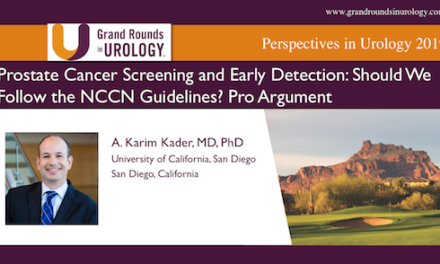Richard G. Stock, MD, presented “Does Anatomic Rectal Displacement Improve Dosimetry and Reduce Injury?” during the Southwest Prostate Cancer Symposium 2020 virtual conference in December 2020.
How to cite: Stock, Richard G. “Does Anatomic Rectal Displacement Improve Dosimetry and Reduce Injury?” December 2020. Accessed Dec 2024. https://dev.grandroundsinurology.com/does-anatomic-rectal-displacement-improve-dosimetry-and-reduce-injury/
Does Anatomic Rectal Displacement Improve Dosimetry and Reduce Injury? – Summary:
Richard G. Stock, MD, Professor of Radiation Oncology and Director of Genitourinary Radiation Oncology at the Icahn School of Medicine at Mount Sinai in New York City, reviews the literature on rectal displacement to prevent damage to the rectum from prostate brachytherapy and external beam radiation therapy (EBRT). First, he summarizes the findings of numerous papers from the past 20 years that have identified a relationship between the dose and volume of radiation and damage to the rectum such as bleeding and mucosal changes. The more radiation reaches the rectum, and the greater the surface area of the rectum affected, the more likely patients will experience adverse effects, including greater levels of morbidity. Dr. Stock then considers how the rectum can be spared, focusing on the evidence around rectal spacers such as endorectal balloons and hydrogel spacers such as SpaceOAR. He explains that numerous studies demonstrate that by inserting a physical barrier between the rectum and the prostate, the rectum is kept separate from the radiation and therefore receives a lower rate of toxicity. Dr. Stock notes that patients experience more rectal discomfort with spacers like SpaceOAR than without, but suggests that the reduction of significant issues such as bleeding outweigh the downsides. He concludes by discussing a recent study of his which found that SpaceOAR can be inserted before brachytherapy and EBRT.
About the Southwest Prostate Cancer Symposium 2020 virtual conference:
Presented by Program Chairs Nelson N. Stone, MD, and Richard G. Stock, MD, this virtual conference educated attendees about advances in the management of localized and advanced prostate cancer, with a focus on imaging, technology, and training in the related devices. It included a scientific session, as well as live demonstrations of surgical techniques. You can learn more about the conference, including the 2021 iteration, here.
ABOUT THE AUTHOR
Richard G. Stock, MD, is a Professor of Radiation Oncology and Director of Genitourinary Radiation Oncology at the Icahn School of Medicine at Mount Sinai in New York City. He has dedicated his career to delivering the highest quality care to patients using the most advanced technology available, including intensity modulated radiation therapy (IMRT), Novalis Shaped Beam Radiosurgery, real-time ultrasound guided prostate seed implants, and MammoSite, all of which allow him to meticulously target tumors while achieving maximal sparing of normal tissues.
Dr. Stock has served on the board of American College of Radiology Testing and the American Brachytherapy Society, where he is member at large, and as guest editor of a special Brachytherapy issue of Techniques in Urology. He has lectured and presented at dozens of meetings and symposiums across the country and internationally, including in New York, San Francisco, Chicago, Philadelphia, Boston, Spain, Holland, France, and Japan.
Dr. Stock completed his internship at Beth Israel Medical Center and his specialty training at Memorial Sloan-Kettering Cancer Center. He is listed in America's Top Doctors.





